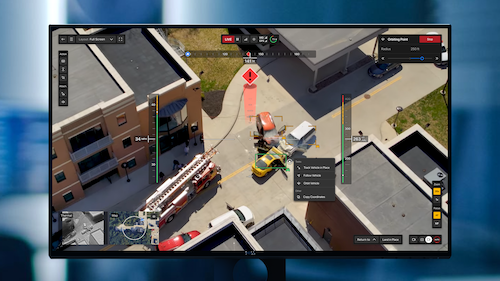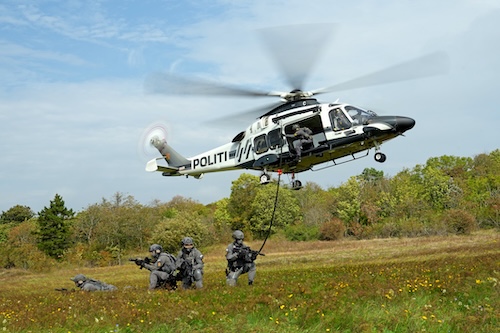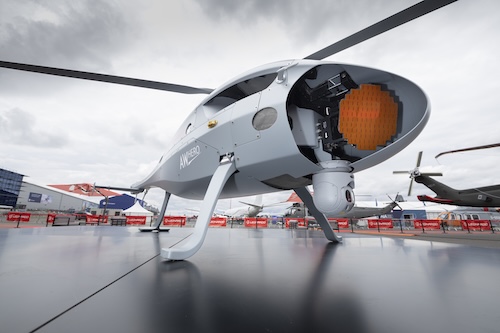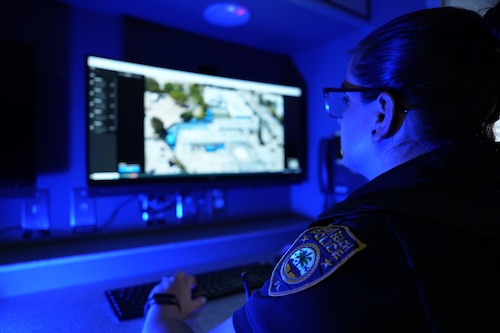|
Aug
25
2025
|
|
Posted 108 days ago ago by Admin
|
|

Far from replacing helicopters, drones are expanding the capabilities of airborne law enforcement by adding cost-effective tools for overwatch, surveillance, search and rescue, and tactical response. As a result, drones are providing police commanders with more options for doing their jobs better. This includes deploying helicopters where they are most needed, rather than for every job imaginable.
Drones: Fast, Affordable, and Flexible
There is no doubt that drones are doing more jobs in airborne law enforcement than ever before. There’s a good reason for this: Drones cost less to fly than helicopters.
“Agencies and departments are under pressure to do more with less: smaller budgets, fewer personnel, and rising expectations,” said Jason LaFond, customer success manager, public safety at Skydio, a drone manufacturer. (LaFond is also a former NYPD detective with 18 years of experience, so he personally understands law enforcement’s needs.) “This fact has driven rapid adoption of drones, particularly autonomous flight systems, because they offer helicopter-like capabilities at a fraction of the cost,” he said.
“Today, drones are being used as first responders, enabling officers to respond with complete visibility in high-risk situations, often facilitating de-escalation,” noted Wayne Baker, director of stakeholder engagement at DJI, another drone manufacturer. He adds, “For example, drones enable officers to plan safer approaches for themselves and suspects in high-risk situations.”
Mike Bucari is senior manager of marketing-Americas at Leonardo Helicopters, which manufactures drones and helicopters. “Drones (AKA unmanned aerial vehicles or UAVs) are becoming more popular due to their relatively low cost, versatility, and ability to provide real-time surveillance,” he said, agreeing with LaFond and Baker. “Today, small-size multirotors are widely used for surveillance, crowd monitoring, search and rescue operations, traffic monitoring, and even in pursuit situations. Drones also allow for the deployment of specialized equipment like thermal imaging cameras, which aid in search operations and tracking suspects at night.“

Helis are Still Vital
The increasing use of drones in airborne law enforcement doesn’t mean that helicopters are on the way out. In fact, “We are seeing an expanded use of helicopters in urban areas, which is increasing the need for aerial assets,” said Bucari. “With this expansion, you are seeing an increase in search and rescue (SAR) missions by police departments, (which is) the kind of work that municipalities did not delve into just a decade ago. You are seeing more and more law enforcement agencies begin to look at SAR/hoist training as another added value that they provide to their officers to better serve their citizens.”
Splitting the Workload
Drones have the advantage of being quick to deploy, are effective for aerial monitoring, and cheap enough to replace that they can be flown into danger. Helicopters provide the ability to move payloads, deploy officers, and remove victims to safety.
Because each of these rotor-based platforms do different things better, splitting the workload between them is relatively easy to do. The result: “Due to their limited payload and range/endurance capabilities, drones are being used primarily for localized surveillance, crowd monitoring, and before SWAT/tactical team insertions,” Bucari said. “Helicopters are still being used for bigger surveillance missions, patrol, integration with ground units, SAR, and SWAT insertions.”
Here’s the balance: “While there will always be a need for helicopters in public safety, some agencies are freeing up these helicopter assets from smaller missions that can be conducted with drones, leaving the heavier aircraft free for missions such as vehicle pursuits or patient transport in difficult terrain,” said Baker. “When helicopters can’t reach an area due to weather or terrain, drones can step in. For example, during Hurricane Helene, the DJI FlyCart 30, which can carry up to 88 pounds, was used to deliver water and medicine to people trapped as the roads were destroyed. In that mountainous terrain, it was not as easy to fly a helicopter to do this task.”

Of course, as drones develop more capabilities, the balance cited above is shifting. Today, “tactical overwatch, SWAT callouts, and even suspect apprehensions are now routinely handled by drones as a lower-cost, easier-to-use, and more flexible alternative,” LaFond said. “For example, drones like Skydio’s X10 can be launched by a remote pilot from a dock on a roof and arrive at the incident scene even before first responders—allowing them to better allocate resources and gain unparalleled situational awareness.”
When They Team Up: Helicopter and Drone Coordination
We have seen how airborne law enforcement commanders can split tasks between drones and helicopters, thanks to their differing strengths. However, there are times when these two platforms are being ‘teamed’ together to deliver superior results — proving the idea that drones and helicopters are complementary, rather than competing, platforms.
“We have seen many examples of helicopters and drones working together,” said Baker. “Several years ago, in Torrance, California, we saw where a search for a suspect of a home invasion was tracked by both a helicopter and a drone. The helicopter was used to distract the suspect, who was moving from one backyard to another. At the same time, the drone was able to track the suspect until they were in a position of vulnerability, at which point they peacefully surrendered.”
So how does drone/helicopter teaming work in practice? “In municipalities that operate both drones and helicopters, both are typically coordinated through a law enforcement agency’s operational control room,” replied Bucari. “The downlink, EO-IR, and moving map systems on the helicopter are usually replicated on the drone. Video feeds from either the drone, helicopter or both are then transmitted to the operational control room and ground personnel to coordinate synchronized movement based on the situation.”
Looking towards the future, Bucari expects helicopters and larger-sized drones to operate in full teaming mode within an airborne law enforcement agency’s mixed fleet. Make no mistake: teaming works! “Leonardo, as an OEM of both helicopters and UAVs, has already successfully demonstrated crewed-uncrewed teaming technologies and capabilities during different operational exercises, challenging high levels of crewed-uncrewed interoperability,” Bucari said. To date, such exercises have included: the 2015 European Defence Agency “Italian Blade” exercise, the 2016 Royal Navy “Unmanned Warrior” exercise, the British Army Warfighting Experiment, and the European Defence Agency’s OCEAN2020.

During the 2024 European Defence initiative MUSHER, a series of teaming exercises were conducted featuring an AW189 super-medium twin-engine helicopter and the Leonardo SW-4 Solo RUAS/OPH (rotorcraft uncrewed aerial system/optionally piloted helicopter) Technology Demonstrator. “During these missions, the AW189 controlled the remotely piloted aircraft at various levels of interoperability via a dedicated mission station installed in the cabin,” said Bucari. “This included real-time visualization and management of the SW-4 Solo’s payloads, up to full UAV control.”
AI and Autonomy: Changing the Game
The success being enjoyed in drone/helicopter teaming is due to the advanced technologies being deployed across the rotorcraft industry. A case in point: “Many new DJI drones feature intelligent features that ensure the safety of the aircraft, pilot, and surrounding environment by providing enhanced situational awareness of terrain obstacles and warnings of crewed aviation approaching, to name a few,” Baker said. “Meanwhile, the intelligent features on our flagship compact enterprise drone, the Matrice 4 Series, allow the drone to serve as a sophisticated second pair of eyes during search and rescue missions.”
No consideration of advanced technologies, with respect to drones and helicopters, would be complete without mentioning the impact of artificial intelligence (AI) on rotorcraft flight.
“Today, AI enables the automatic processing and analysis of large volumes of data from aerial surveillance systems,” said Bucari. “For example, AI algorithms can identify and track objects, vehicles, or individuals in real-time, improving the accuracy and speed of threat detection.”
“AI and autonomy are game changers,” LaFond observed. “Skydio invested early and big in AI and autonomous technology, and it’s paying off. Now, their drones can navigate tight urban areas, avoid obstacles, and track suspects entirely autonomously — all while sharing a live feed with dispatchers and first responders.”

What’s Next
The addition of drones to airborne law enforcement’s arsenal is definitely boosting its capabilities and mission options. Yet, more promising possibilities are on the horizon. For example, “The next phase is scale, and that’s where drone hives [a deployment model where multiple docks are prepositioned together in groups throughout a city to ensure continuous overwatch during long incidents] come in,” said LaFond. “By using a drone-hive approach, departments can maintain coverage across high-priority zones, respond to multiple calls from one site, and keep drones on-scene longer by swapping them instead of flying back to base. Thanks to faster BVLOS (beyond visual line of sight) waivers, which we help agencies secure, this level of autonomy is more accessible than ever. Airborne law enforcement is rapidly being redefined.”
“In the future, once the technology improves, you could see AI-powered tools like facial recognition, license-plate recognition, and anomaly detection be deployed from drones and helicopters,” Bucari said. “These AI-based systems could automatically flag suspicious activity, reducing the need for constant human monitoring.”
Will these advances affect humanity’s role in airborne law enforcement? Absolutely! Still, changing this role does not mean eliminating it. “Drone pilots will always have a place in airborne law enforcement,” said Baker. “DJI drones are designed to be piloted by a human operator as outlined by the FAA’s Beyond Visual Line of Sight (BVLOS) regulations. And while some of our drones can be programmed for automated missions with an FAA waiver, a human operator can always take control and fly the drone as the situation dictates. Additionally, as mentioned previously, crewed aviation assets, such as helicopters, will always be needed for conditions that require longer flight times, such as vehicle pursuits or the transport of individuals in disaster situations.”
“The role of people in airborne law enforcement is just evolving,” LaFond said. “Human judgment and accountability will always be essential. It’s just that some of the more routine tasks, such as manual flying, positioning, and data processing, are becoming increasingly autonomous. When it comes to autonomous drones, operators are more of a mission supervisor than hands-on pilots, but humans are still in the loop. Moreover, we’ll soon see single humans operating multiple drones simultaneously. That shift will enable faster, safer and more effective responses while reducing cognitive load.”
The bottom line: When it comes to the future of airborne law enforcement, “there will always be a need for a human to be in command and to think on their feet,” concludes Bucari.
READ MAY/JUNE ISSUE OF ROTOR PRO
READ MORE ROTOR PRO: https://justhelicopters.com/Magazine
WATCH ROTOR PRO YOUTUBE CHANNEL: https://buff.ly/3Md0T3y
You can also find us on
Instagram - https://www.instagram.com/rotorpro1
Facebook - https://www.facebook.com/rotorpro1
Twitter - https://twitter.com/justhelicopters
LinkedIn - https://www.linkedin.com/company/rotorpro1